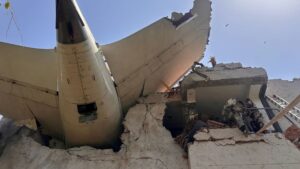Tragedy Strikes: Air India Flight 171 Crashes Shortly After Takeoff
In a heartbreaking incident, Air India Flight 171, a Boeing 787 Dreamliner, crashed mere moments after departing from Ahmedabad, India, with 242 passengers and crew on board. This tragic accident has garnered attention not only for its immediate human toll but also for its potential implications on the aviation industry and market reactions.
The Incident
On June 12, 2025, Air India’s Chairman N Chandrasekaran confirmed that the flight was bound for London Gatwick Airport when it was "involved in a tragic accident." Eyewitness reports indicate that the aircraft reached a maximum altitude of approximately 625 feet before beginning its descent at a concerning rate of 475 feet per minute.
While the cause of the crash remains undetermined and could take months to investigate, protocols dictate that the country where the incident occurs will lead the investigation. This includes collaboration with aircraft manufacturers and engine makers, posing crucial questions about the safety measures in place.
A Closer Look at the Aircraft
The Boeing 787 Dreamliner has been one of the best-selling wide-body jets, designed for long-haul flights. Delivered to Air India in 2014, the aircraft’s track record has generally been commendable. However, this incident raises critical concerns about the long-term implications for both Boeing and Air India.
Key Industry Implications
-
Market Reactions: Following the crash, Boeing’s stock took a significant hit, falling over 7% in premarket trading. This incident resonates deeply, especially as it comes on the eve of the prestigious Paris Air Show, where both Boeing and Airbus are set to unveil hundreds of aircraft orders.
-
Safety Protocols: Boeing has been actively working to rebound from previous safety and quality crises. However, this incident prompts essential questions about whether this crash could signal deeper systemic issues within Boeing’s quality assurance processes.
- International Investigations: The investigation will involve multiple stakeholders, including the nation’s aviation authorities, the manufacturer, and independent experts. Understanding the cause of this crash is crucial not only for accountability buts also for the future of aviation safety protocols globally.
Immediate Response and Aftermath
In the wake of the incident, Sardar Vallabhbhai Patel International Airport temporarily suspended flights, although operations were resumed a few hours later. India’s aviation minister, Ram Mohan Naidu Kinjarapu, tweeted about the ongoing rescue efforts, emphasizing that support and medical aid were being dispatched promptly to assist any victims.
Local authorities and Air India are working tirelessly to provide assistance to the affected families, which highlights the human element of these tragic events.
Looking Ahead
While the story continues to develop, the ramifications of this crash extend beyond just financial markets and technical investigations. The aviation industry must come together to ensure that such tragedies are mitigated in the future. This incident serves as a poignant reminder of the stakes involved in air travel and the critical importance of safety within the aviation sector.
At Extreme Investor Network, we will keep a close watch on this developing story. Our insights will not only focus on the current repercussions but will also analyze the long-term impacts on the aviation industry, investments in safety technology, and market trends.
Stay tuned for updates as we delve deeper into the analysis and future implications stemming from this tragic event.

